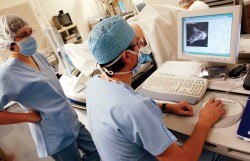BPH Surgical Options
 Enlarged prostate surgery presents options for a variety of severe symptoms which, if left unattended, may pose life-threatening complications in the lower urinary tract, colon-rectal environment, and other vital organs due to the spread of prostate cancer cells.
Enlarged prostate surgery presents options for a variety of severe symptoms which, if left unattended, may pose life-threatening complications in the lower urinary tract, colon-rectal environment, and other vital organs due to the spread of prostate cancer cells.
Acute Symptoms. The need for surgery may be brought on by the following symptoms-
- Failure to control bladder and urination urgencies (incontinence)
- Presence of blood traces in urine samples
- Incomplete urine discharge from the bladder (urinary retention)
- Recurring infections of the urethra, bladder and kidneys
- Renal failure (kidney)
- Sedimentary deposits in the bladder (stones)
Surgical Options. Medical options for surgery to address symptoms will be based on the severity and location of your symptoms, plus the size and the configuration of the prostate gland itself. The options include the following-
- Prostate Resection (TURP):When it comes to benign prostatic hyperplasia, this procedure is most commonly deployed for symptomatic relief. The urethra is under intense contact pressure from the prostate, which acts like a fist clenching around a straw. Flow is restricted from the bladder to the urine exit point at the end of the urethra causing incomplete discharge, urine retention, urination pain, and sudden urges. The flow restriction causes hygienic compromises within the urinary tract where bacteria can fester causing inflammation, ductile infections, and urethral and bladder tissue degeneration and weaknesses. To relieve the restrictive contact between the prostate and urethra, sections of the gland are removed “across the urethra” or “transurethral” allowing urine to flow and pressure to be relieved.
- Prostate Incision (TUIP): This is a low-intensity alternative to the TURP in that it is a localized laser-based procedure on a minute area of the prostate gland where it meets the bladder. The bladder neck region joins the urethra by virtue of a set of sphinctral muscles which must relax to an open position when stimulated by healthy nerves in the bladder. This area of bladder-prostate gland nexus is small enough to not warrant a hospital stay following the completion of the procedure. A small endoscope is inserted through the opening of the penile area of the urethra. The telescopic action is employed until the prostate-bladder nexus point is reached. A small incision removes overgrown prostatic tissue that is interfering with the outlet muscles.
- Major Removal of the Prostate: A full prostatectomy requires a 5-10 day hospital stay for recovery. The prostate removal occurs through the perineal extraction procedure via an incision between the scrotum and the anus. This procedure is generally to remove a prostate so enlarged that LUTS have become too severe to treat any other way. It is also the most common removal procedure for cancerous prostate conditions.
Surgical Side Effects. There are many with major implications for patient quality of life. The prostate gland is part of the male reproductive system. The prostate is located in a nerve rich region of the anatomy having to do with erectile function. Removal of the prostate can affect erectile function resulting in irreconcilable impotence, the inability to achieve erection. The prostate is also part of the seminal production functionality of the male body. Semen can backflow into the bladder rather into the penis. This condition is known as “retrograde ejaculation.” There are negative effects on male fertility. Urinary incontinence is a continuing side effect of prostate surgery. There is no research evidence to suggest which of these complications occurs with standard measureable frequency for any particular surgical option.
